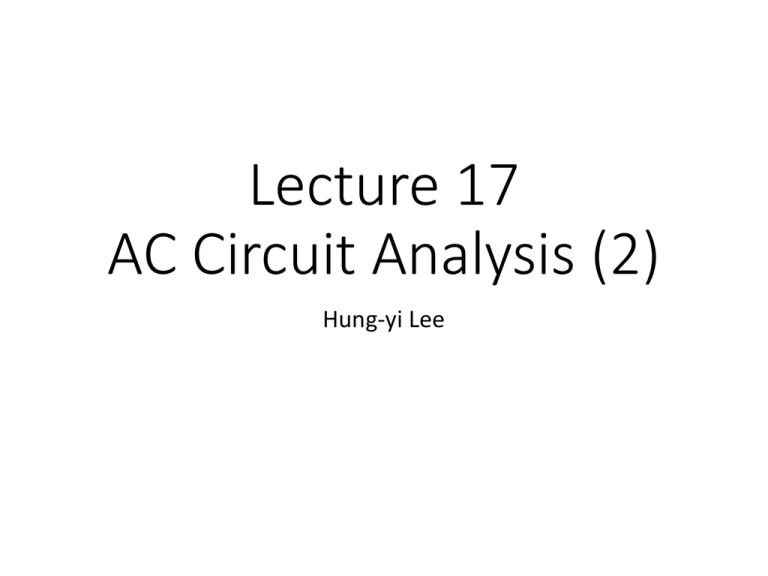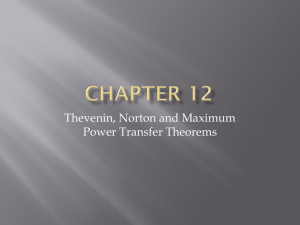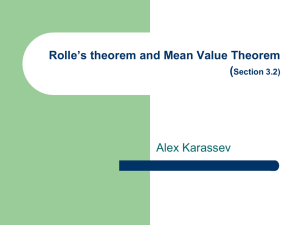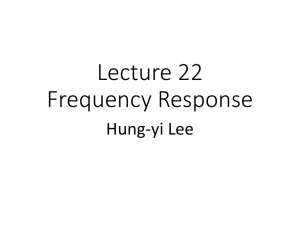PowerPoint **
advertisement

Lecture 17 AC Circuit Analysis (2) Hung-yi Lee Textbook • AC Circuit Analysis as Resistive Circuits • Chapter 6.3, Chapter 6.5 (out of the scope) • Fourier Series for Circuit Analysis • Resonance • Chapter 6.4 (out of the scope) • Oscillator • Example 9.7 and 6.10 Systematic Analysis for AC Steady State Example – Node Analysis I1 I 2 I 3 I 4 0 I2 I1 3 I3 V2 V1 4 0 V1 3j I4 ? V1 I 4 I1 I 2 V2 I3 Example – Node Analysis I1 I 2 I 3 I 4 I 5 I 6 0 V1 V2 1045 Supernode I3 I 4 V1 I1 I2 V2 I6 I3 I 4 I5 Example – Node Analysis I1 I 2 I 5 I 6 0 I1 3 I2 V1 V2 1045 Supernode I5 0 V2 1045 3j I6 V1 I1 I2 V2 I6 I3 I 4 I5 0 V2 6j 0 V2 12 Thevenin and Norton Theorem for AC Steady State Thevenin & Norton Theorem • DC circuit Thevenin Theorem Two Terminal Network voc i sc Rt i sc Rt Norton Theorem Thevenin & Norton Theorem • DC circuit • Find the Thevenin parameters Suppress Sources it Two Terminal Network voc Two Terminal Network isc Two Terminal Network vt Rt it vt Thevenin & Norton Theorem • AC steady state ZT Voc Two Terminal Network I sc Thevenin Theorem Voc Zt I sc ZT Norton Theorem Thevenin & Norton Theorem • AC steady state • Find the Thevenin parameters Suppress Sources Two Terminal Network Voc Two Terminal Network I sc Two Terminal Network Zt Vt It It Vt Example - Norton Theorem • Obtain Io by Norton Theorem I sc ZT Example - Norton Theorem • Obtain Io by Norton Theorem • Find Zt Suppress Sources Two-terminal Network Zt 5 Example - Norton Theorem • Obtain Io by Norton Theorem I sc 3 8 j • Find I sc I2 I1 Two-terminal Network I sc Example - Norton Theorem • Obtain Io by Norton Theorem 38 j 5 I o 3 8 j 1.46538.48 5 20 15 j 5 Superposition for AC Steady State AC Superposition – Example 6.17 Z L j L Find vc ZC 1 j C However, what is the value of ω? 5 ?, 2 ? AC Superposition – Example 6.17 Superposition Principle v C-1 v C-2 v C v C-1 v C-2 AC Superposition – Example 6.17 v C v C1 v C2 v C1 v C2 The same element has different impedances. AC Superposition – Example 6.17 3j 3 j 50 10 j 50 j 50 10 j 5 j 50 j 5 j 55.7 158.2 V C 1 60 50 j 20 j 5 j vC 1 t 55.7 cos(5t 158.2 ) V 8 j 25 j 200 200 j 8 j 25 j 17 j 17 50 200 50 j 17 200 IC 2 j 34.4166.8 17 IC 2 3 j V C 2 vC 2 t 34.4 cos(2t 166.8 ) V Fourier Series for Circuit Analysis Beyond Sinusoids vs t 1. Fourier Series: periodic function is a linear combination of sinusoids 2. Superposition: find the steady state of individual sinusoids, and then sum them together Fourier Series • Periodic Function: f(t) = f(t+nT) • Period: T • Frequency: f0 = 1/T • Circular Frequency: ω0 = 2πf0 = 2π/T Fourier Series: cos n0t 90 You will learn how to find a0, an and bn in other courses. Fourier Series f t 1 2 1 f t sin 2k 1t 2 k 1 2k 1 Fourier Series f t Fourier Series f t Fourier Series f t cos n0t 90 Network Network Network = I1 i0 I2 Network Capacitor = Open Inductor = Short …… Example vs t 1 2 1 vs t sin 2k 1t 2 k 1 2k 1 1 2 2 2 vs t sin t sin 3t sin 5t ... 2 3 5 Example 1 2 1 vs t sin 2k 1t 2 k 1 2k 1 cos 2k 1t 90 v0 t 0 5 2 1 Vs 90 2k 1 2k 1 j 2k 1 2 Example 1 2 1 vs t sin 2k 1t 2 k 1 2k 1 v0 t 0 1 22k 1 cos 2k 1t tan 2 2 5 25 42k 1 2 Example 1 2 2 2 vs t sin t sin 3t sin 5t ... 2 3 5 1 0.64 sin t 0.21sin 3t 0.13 sin 5t ... 2 vo t 0.50 cos t 51.49 0.21 cos 3t 75.14 0.13 cos 5t 80.96 ... Example Example Application: Resonance Communication How to change audio into different frequency? AM Frequency at f Frequency close to f FM Frequency at f Frequency close to f Communication How to design a circuit that can only receive the signal of a specific frequency? Series RLC Z ( ) R jL 1 j L C 1 R j C 1 2 Z ( ) R L C tan 1 I V Z 1 C R L I I m i Vm Im | Z | 2 V Vm v Vm 1 2 R L C 2 Series RLC 1 Z ( ) R 2 L C 1 LC 2 1 L C tan 1 R 0 I I m i V Vm v Im Vm Im | Z | Fix Vm Change ω 1 LC Resonance Im Antenna 1 LC If the frequency of the input signal is close to ω0 Large current I I m i V Vm v Otherwise Like open circuit 0 Series RLC - Bandwidth Vm Im | Z | Im Vm R 1 Vm 2 R 1 LC Vm 1 R L C 2 2 2 1 R L 2R C 2 B 2 1 R / L Quality Using quality factor Q to define the selectivity Q 0 B R B L 0 L Q R Quality • For radio, cell phone, etc., the quality should be • 1. As high as possible? • 2. As low as possible? • 3. None of the above? Application: Oscillator Oscillator • Oscillator (Example 9.7 and 6.10) • An oscillator is an electric circuit that generate a sinusoidal output with dc supply voltage • DC to AC Remote Controller, Cell phone Oscillator - Example 6.10 Vx ? First Find V in Oscillator - Example 6.10 Vx R I 2 V1 R jL I 2 j L I1 1 I 2 R R V1 j L I1 I 2 2 I 2 R j Vin I1 I 2 V1 C j L j 2 I 2 R jL I 2 R C j2 L R j L I 2 C RC L 2 Vin R L I 2 j RC C Oscillator - Example 6.10 L 2 Vin R L I 2 j RC C Vx R I 2 2 L Vin L C 1 2 j Vx RC R If we want vin and vx in phase Vin Vx 2 L C 0 osc R 2 LC Oscillator - Example 6.10 osc 2 (vin and vx in phase) LC Vout KVx Vin Vout 2 L Vin L L C 1 2 j 1 2 Vx RC R RC 1 L 1 2 K R C If we want vin = vout L K 1 2 RC Oscillator - Example 6.10 osc 2 LC L K 1 2 RC osc 2 LC L K 1 2 RC L Set K 1 2 RC vin = vout Input: vin t Vm cososc t vout t vin t Use output as input Oscillator - Example 6.10 osc 2 LC L K 1 2 RC Generate sinusoids without input! Will the oscillation attenuate with time? Yes. R dissipate the energy No. Who supply the power? Amplifier Oscillator - Example 6.10 TV remote controller osc 2 LC L K 1 2 RC Battery of controller Oscillator - Example 9.7 osc 2 LC L K 1 2 RC d 2vout 1 R dvout 2 K 1 vout 0 2 dt RC L dt LC L Set K 1 2 RC 1 R K 1 0 RC L Undamped Oscillator - Example 9.7 osc 2 LC L K 1 2 RC d 2vout 1 R dvout 2 K 1 vout 0 2 dt RC L dt LC 2 j LC josc vout t a cos osct b sin osct Amplitude and phase are determined by vout t L cososct initial condition Homework • 6.46 • 6.52 • 6.44 Homework – Mesh Analysis 1 𝑓𝑖𝑛𝑑 𝐼 𝐼 Homework – Mesh Analysis 2 𝑓𝑖𝑛𝑑 𝑉 𝑉 Homework – Thevenin 1 • Find the Thevenin equivalent of the following network Homework – Thevenin 2 • Find the Thevenin equivalent of the following network Homework – Superposition 1 • (out of the scope) Calculate vo Homework – Superposition 2 • (out of the scope) Calculate vo Thank you! Answer • 6.46: v2=8cos(5t+53.1。) V 5 V 0 , V 26 . 9 V 21 . 8 • 6.52: 1 2 • 6.44 1 1 osc 6 RC Answer – Mesh Analysis 1 Answer – Mesh Analysis 2 𝑉= Answer – Thevenin 1 • Find the Thevenin equivalent of the following network Answer – Thevenin 2 • Find the Thevenin equivalent of the following network Answer – Superposition 1 • Using superposition 1 2.498 cos 2t 30.79 2.33 sin 5t 12.1 Answer – Superposition 2 • Using superposition Acknowledgement • 感謝 陳俞兆(b02) • 在上課時指出投影片中的錯誤 • 感謝 趙祐毅(b02) • 在上課時指出投影片中的錯誤 • 感謝 林楷恩(b02) • 修正作業的答案









